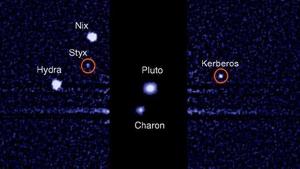Blog
Dance of the Moon
5 June 2015
As the New Horizons spacecraft approaches Pluto, there’s a great deal of anticipation about just what we’ll learn about the dwarf planet. One of the key areas of interest is Pluto’s moon system. We know that Pluto has at least five moons, with Charon being the largest by far, and four smaller moons Styx, Nix, Hydra and Kerberos. From Hubble observations, we know that Hydra and Nix seem to have oblong shapes. We know this from their varying brightness over time, which suggests that their rotation means that sometimes a wide side faces us (making it appear brighter) and other times a narrow side faces us (appearing dimmer). There’s a small chance that this variation in brightness could be due to a radically different albedo on different sides of the moons, but that isn’t likely to be the case. In fact recent research on Nix would further points to its elongated shape.
 NASA/Hubble
NASA/HubbleBy our best estimates, Nix is shaped roughly like an American football, and is about 57 km on its long side and 27 km along its short side. Because of this irregular shape, the gravitational pull of Pluto and Charon exert a twisting force (torque) on the small moon. If Nix simply orbited a single mass, then this torque effect would tend to stabilize the moon, and perhaps even cause it to tidally lock similar to the way our Moon is tidally locked to Earth. But because Nix is pulled by two large bodies orbiting each other, the torque is irregular. Recent computer simulations show that Nix would therefore have a chaotic motion where its rotation doesn’t follow a regular pattern. As a result, the apparent brightness of Nix should vary in a chaotic way.
This is what Hubble observations find. If Nix were roughly spherical and its brightness variations were simply due to varying albedo, we would expect them to follow a regular pattern. So it would seem that Nix is truly oblong. Of course to know for sure, we’d like to get some direct images of the small moon, which we’ll hopefully get during the Pluto flyby.